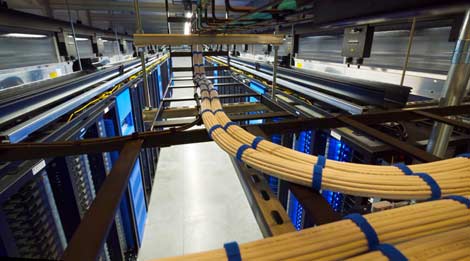Digital Realty to Adapt Open Compute DesignsDigital Realty to Adapt Open Compute Designs
Data center developer Digital Realty Trust is adapting its multi-tenant data center design to give customers the option of implementing elements of the Open Compute Project, the open source hardware initiative founded by Facebook.
November 11, 2011

opencompute-power
The overhead cabling in the Facebook data center in Prineville, Oregon, where the initial Open Compute Project designs were implemented.
Are the custom hardware designs from the Open Compute Project only useful to companies building huge data centers? Or will they ever be practical for companies with smaller data centers? A new participant in the Open Compute initiative could play a crucial role in answering these questions.
Data center developer Digital Realty Trust has joined the project, and is adapting its multi-tenant data center designs to give customers the option of implementing elements of the Open Compute designs. The company will continue to use standard power for new buildings, but will also develop an optional layout incorporating the power architecture used in Open Compute.
"One of the criticisms of Open Compute is that many companies start out in leased facilities," said Frank Frankovsky, Chairman and President of the Open Compute Project and Director of Technical Operations at Facebook. "Digital Realty is stepping up and show that Open Compute Project designs can work in these environments."
Making Cutting-Edge Design Accessible
The Open Compute Project was launched in April to publish data center designs developed by Facebook for its Prineville, Oregon data center, as well as the company’s custom designs for servers, power supplies and UPS units. Facebook’s decision to open source its designs prompted expectations that the move could democratize data center infrastructure, making cutting-edge designs available to companies that can’t afford their own design team.
While it might be straightforward for companies to integrate the Open Compute designs when building their own data centers, Facebook’s customizations provide challenges in multi-tenant facilities. These include servers that operate at 277 volts of AC power instead of the traditional 208 volts, a cooling design optimized for warmer data center temperatures, and the use of fresh air cooling instead of chillers – a strategy which works primarily in cool climates.
Enter Digital Realty Trust, the world's largest operator of data center space, with a portfolio of 100 facilities spanning 17 million square feet of space in 30 cities around the globe. It's the largest player in the wholesale data center business, where providers supply customers with turn-key suites and “pods” of finished data center space
"Digital can act as an enabler for people who are not at Facebook's scale to take advantage of this," said Jim Smith, the Chief Technology Officer for Digital Realty Trust. "It opens up a professional opportunity for us. It's very simple for us to make an adaptation and deploy Open Compute designs. We are focused on what's going on in the industry, and we're all focused on efficiency."
Open Compute, by the Pod
Digital Realty has developed a standard design for multi-tenant data centers, featuring a 1.125 megawatt "pod" of raised-floor space. "We have begun a process to localize the Open Compute power architecture to Digital Realty pods," said Smith. "The key component we're going to maintain from our layout is the capacity of the (electrical) service entrance."
Digital's Open Compute pods will use the same generator, transformer and breaker configurations as its existing facilities, but will adopt the more streamlined Open Compute power distribution design. Open Compute servers include power supplies that allow servers to use 277-volt AC power instead of the traditional 208 volts. This allows power to enter the building at 277/480 volts and come directly to the server, bypassing the step-downs seen in most data centers as the power passes through UPS systems and power distribution units (PDUs).
For now Digital Realty is preparing the new design, and in discussions with companies interested in turn-key space that supports Open Compute specs. "We've got some interest from some of the Open Compute partners," said Smith. While the new configuration will make Open Compute designs accessible to companies requiring as little as 1 megawatt of capacity, the most interested users are likely to be larger companies, Smith said.
"I wouldn't be surprised if one of our customers in the 10 megawatt range might wind up being interested in this," he said. "Some of these requirements in the 5 to 15 megawatt range, it seems like it might be a no-brainer for them."
While Digital Realty can adapt the Open Compute electrical design, the cooling design is another matter. Facebook's Prineville facility uses a two-story design in which the entire upper floor functions as a cooling plenum, dropping cool air into the data center from overhead. Digital Realty uses a raised-floor design, in which cool air enters the room through perforated tiles in the floor.
"They're really doing a building-level cooling plan in Oregon," Smith said of Facebook. "The main reason we do raised floor is that the vast majority of data center users expect to see a raised floor. The other thing it does is gives us tremendous flexibility for containment."
About the Author
You May Also Like







